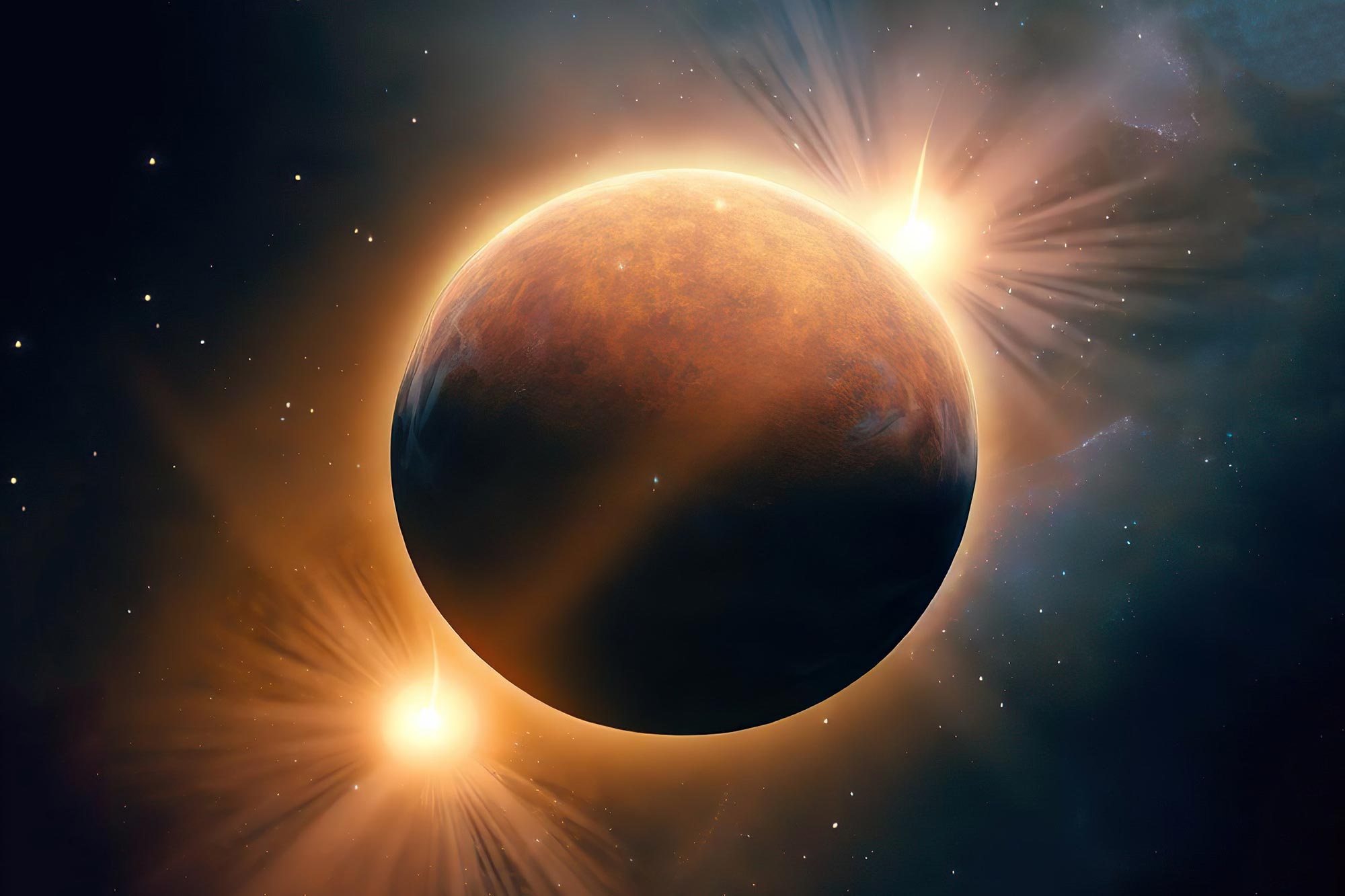
Международная группа астрономов объявила об открытии второй планеты в редкой многопланетной круговой системе, известной как BEBOP-1 или TOI-1338. Эта планета, названная BEBOP-1c, была обнаружена с помощью доплеровского метода, в котором масса планеты определяется путем измерения скорости звезд. BEBOP-1c имеет период обращения 215 дней и массу в 65 раз больше, чем у Земли.
Международная группа астрономов объявила о втором в истории открытии круговой многопланетной системы.
астрономы в[{» attribute=»»>University of Birmingham have discovered a second planet, named BEBOP-1c, in the rare multiplanetary circumbinary system BEBOP-1 or TOI-1338. This discovery, made using the Doppler method, is essential in expanding our knowledge about planetary creation around two stars.
Circumbinary systems contain planets that orbit around two stars in the center instead of just one, like in our Solar System. Circumbinary planets orbit around both stars at once. The discovery, led by researchers at the University of Birmingham, is reported in today’s issue of the journal Nature Astronomy.
The newly discovered planet is called BEBOP-1c, after the name of the project that collected the data. BEBOP stands for Binaries Escorted By Orbiting Planets. The BEBOP-1 system is also known as TOI-1338.
In 2020, a circumbinary planet, called TOI-1338b, was discovered in the same system using data from NASA’s TESS space telescope, to which the Birmingham team also contributed. That planet was discovered with the transit method and was noticed because it passed in front of the brighter of the two stars on several occasions.

Illustration celebrating the discovery of the circumbinary planet BEBOP-1c using the radial-velocity method. Astronomers rarely put their eye to the telescope, but instead the data comes directly to their computers and laptops where it is analyzed and interpreted. BEBOP-1c was detected using the ESPRESSO instrument at the Very Large Telescope in Chile, and by HARPS, at the 3.6m telescope also in Chile. Both are operated by ESO, the European Southern Observatory. Credit: Amanda Smith / University of Birmingham
“The transit method permitted us to measure the size of TOI-1338b, but not its mass which is the planet’s most fundamental parameter,” said lead author Dr. Matthew Standing, who completed his PhD at the University of Birmingham and is now a researcher at The Open University.
The BEBOP team was already monitoring this system using another detection method at the time, called the Doppler method. This method, also called the wobble method, or radial-velocity method, relies on accurately measuring the velocity of stars.
“This is the same method that led to the first exoplanet detection, for which Mayor and Queloz received the Nobel Prize in 2019.” said Matthew’s then supervisor, Amaury Triaud, a professor at the University of Birmingham.
Using state-of-the-art instruments installed on two telescopes located in the Atacama Desert in Chile, the team attempted to measure the mass of the planet noticed by TESS. Despite their best efforts, and years of work, the team could not achieve that, but instead they discovered a second planet, BEBOP-1c and measured its mass.
“Only 12 circumbinary systems are known so far, and this is only the second that hosts more than one planet,” said David Martin, an astronomer and Sagan Fellow at the Ohio State University.
“BEBOP-1c has an orbital period of 215 days, and a mass 65 times larger than Earth, which is about five times less than Jupiter’s mass,” continues Dr. Standing. “This was a difficult system to confirm, and our observations were interrupted by the COVID pandemic when telescopes in Chile closed for six months during a critical part of the planet’s orbit. This part of the orbit only became observable again last year, when we finalized the detection.”
At the moment only two planets are known in the TOI-1338/BEBOP-1 circumbinary system but more might be identified in the future, with similar observations as performed by the team.
Although rare, circumbinary planets are important in pushing the understanding of what happens when a planet is created.
“Planets are born in a disc of matter surrounding a young star, where mass progressively gathers into planets,” explains Dr. Lalitha Sairam, a researcher at the University of Birmingham and second author of the study.
“In the case of circumbinary geometries, the disc surrounds both stars. As both stars orbit one another, they act like a giant paddle that disturbs the disc close to them and prevents planet formation except for in regions that are quiet and far away from the binary. It is easier to pinpoint the location and conditions of planet formation in circumbinary systems compared to single stars like the Sun”.
The team does not yet know the size of BEBOP-1c, only its mass, however researchers will attempt using the transit method now to measure the size of BEBOP-1c.
Despite not detecting the inner planet, TOI-1338b, the team was able to place strict upper limits on its mass. It is now known that planet has a density lower than a Victoria Sponge cake, a rarity that makes this planet optimal for further studies with the James Webb space telescope. If these observations happen, they might reveal the chemical environment in which this rare circumbinary planet formed.
Reference: “Radial-velocity discovery of a second planet in the TOI-1338/BEBOP-1 circumbinary system” by Matthew R. Standing, Lalitha Sairam, David V. Martin, Amaury H. M. J. Triaud, Alexandre C. M. Correia, Gavin A. L. Coleman, Thomas A. Baycroft, Vedad Kunovac, Isabelle Boisse, Andrew Collier Cameron, Georgina Dransfield, João P. Faria, Michaël Gillon, Nathan C. Hara, Coel Hellier, Jonathan Howard, Ellie Lane, Rosemary Mardling, Pierre F. L. Maxted, Nicola J. Miller, Richard P. Nelson, Jerome A. Orosz, Franscesco Pepe, Alexandre Santerne, Daniel Sebastian, Stéphane Udry and William F. Welsh, 12 June 2023, Nature Astronomy.
DOI: 10.1038/s41550-023-01948-4

«Наркоман поп-культуры. Поклонник телевидения. Ниндзя алкоголика. Абсолютный фанат пива. Профессиональный знаток твиттера».






More Stories
SpaceX успешно запустила группировку навигационных спутников для Евросоюза
Замечена пара массивных плазменных струй, вылетающих из гигантской черной дыры Черные дыры
Драматические изображения гигантской полнолуния и частичного лунного затмения